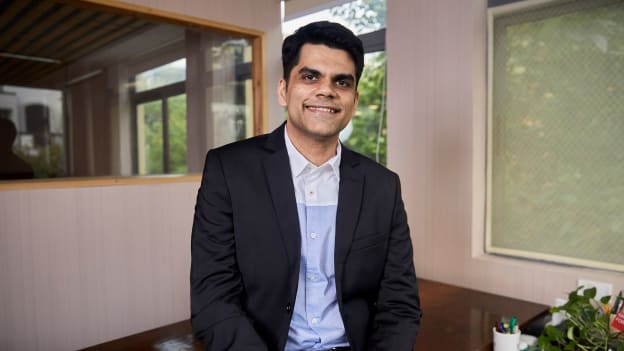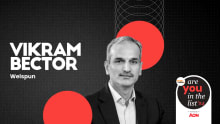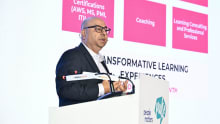L&D initiatives must become a part of people’s career conversation: Hero Vired’s Satyajit Menon

Returning to work in the new normal comes with its own set of challenges. Organisations have to adapt to this massive transformation in the world of HR and data and come up with inventive strategies to keep their workforce engaged and continuously learning. In a recent interview with People Matters, Satyajit Menon, SVP & Head, People & Culture, Hero Vired raises the importance of continuous feedback and conversations with the workforce, cross-skilling, gearing L&D initiatives to enable people to climb up the ladder and carrying out well-researched strategies that cater to the unique need of each organisation.
Satyajit has over 20 years of work experience across domains in consulting, outsourcing, and new-age tech startups, leading international teams across North America, Europe, and Asia for companies such as GE, Lehman Brothers, Fidelity, and Snapdeal. He has a strong track record of building dynamic and agile teams, promoting exciting career opportunities for talent internally, and enabling a highly engaged workforce. He is also a certified commercial pilot and an Economics graduate from MG University, Kerala.
Here’s some excerpts from the interview.
Q. In the face of the massive transformation that has come about in the world of people and work due to the pandemic, what are some of the key driving values which will enable leaders to adapt and overcome the challenges of this time?
Organisations learned and adapted a lot as a result of this transition. One of them was the shift in focus towards providing a seamless experience to the learner when it came to learning interventions and providing relevant content today and in the near future. This can be done through curating material that is not simply helping the learner or the employee but providing opportunities. It has to be a structured approach geared towards learner engagement as well as both upskilling and reskilling.
From a leader’s perspective, they have to play a significant role in anticipating new opportunities for the business which will shape the future of the company and have an on-ground approach in assessing the capabilities of their people. Simultaneously, empathy and a tremendous level of compassion is a must. While the world may have caught on to the habit of working remotely, leaders must acknowledge the constraints that come with learning remotely.
Q. Given how the hybrid model is the face of the new normal which raises its concerns, what are some of the strategies implemented by Hero Vired to carry out this change?
When the pandemic first hit us, we had questions concerning getting covid and contagion as well as how to carry out work. What we did to mitigate that risk at the very beginning was creating a unique mirror model. During the second wave, which hit us hard, we would lose a lot of our resources, so following this mirror model, we would cross-train within the teams of any size and transfer basic, intermediary skills. So what we did was create mirror pods, a team of 10 would be broken into five members each, these two teams would be cross trained wherein one team worked within the office,and the other worked remotely. A weekly roster was maintained according to which teams would carry out work, and no teams were interchanged. Experts who provided technical and functional training were both external and internal. This pod-based structure really helped because we created role-clones for each team in the following few weeks. Teams who now need to collaborate with one another come on specific days of the week,and it is starting to operate like clockwork. This pod structure was extended beyond Delhi NCR, and the roster was made to accommodate people from other regions as well, which also falls in line with the hybrid model.
Q. A continuous learning culture is a must-have for organisations to thrive in the new world of work. What are some of the L&D initiatives carried out to bridge existing skill gaps?
If we look at data, last year in its report, the World Economic Forum (WEF) had mentioned how the rise of machines and automation would make 85 million jobs obsolete by 2025. Two things in that report that caught my attention were how organisations would have to continuously upskill and reskill at least 40% of their workforce; and how 94-95% of leaders expected their people to pick up new skills.
What is evident is that there is a massive pressure on leaders and L&D interventions boil down to making careers for people. This creation is more than performance management; it’s also about regular communication on what people need and what can help them be more successful.
At Hero Vired, we always try to make sure that L&D initiatives are a part of someone’s career conversation. We are working with learning partners, assigning internal mentors who are both domain and functional experts as well as tying the onboarding process with a rigorous bootcamp program where people spend the first 0-30 days trying to understand the business as well as what technologies we are a part of. This bootcamp, with the help of our internal experts, empower the new hires to be company ready and deliver. We also have monthly conversations to gain feedback on the programs being carried out.
There’s plenty of talk about upskilling, but cross-skilling is equally important. In the new normal, being able to cross-pollinate teams in order to avoid dependency on one person or one team is really critical. Our learning strategy is geared towards taking full care of the initial learning process and once the quarter is over, we follow it up with monthly conversations which push our people to think about where they want their careers to go.
Q. Delivering and measuring the impact of any HR initiative is a critical step to accordingly plan for the future. Could you share some insights on how people analytics and hard data can help deliver actionable insights for business growth?
A recent Deloitte survey pointed out how 71% of the companies who took the survey considered people analytics to be a high priority, the reason being that the first scorecard that businesses see today, including Hero Vired, is people. We are a company that encourages retention, and this happens through predictive modelling. Our stability monitor, through a series of very pointed questions, is able to predict the likelihood of someone leaving the organisation in the next 3-6 months. These questions are very symptomatic of what prompts an employee to leave, and this report is 75-80% accurate. If companies are able to adopt such a predictive model, it will provide critical feedback. Transparency is also important especially when it comes to data, our scorecard is visible to everybody. and we have monthly town halls where everyone gets to find out how the business is doing.
Q.Organisational culture continues to be significant in building a positive, inclusive work environment and drives employee engagement and wellbeing as well. In the post-pandemic hybrid world of work, how will leaders go about ensuring that this culture is intact and strengthened?
What the pandemic has taught us is that leaders need to trust their employees; they need to adapt and show a lot of empathy. Even though there were companies practising remote work prior to the pandemic, there were so many industries that were dependent on people coming to the office. Engagement surveys carried out every six months are no longer going to work, you have to ask questions every week and review people’s performance much more frequently. Everyone needs to have a razor-sharp focus on what they’re going to achieve. Objectives have to be identified and measured with key results, and metrics must be followed up and reviewed consistently.
There are a couple of questions that leaders must ask and answer to ensure that this culture of building a positive workplace is sustained. Are employees clear about what they have to achieve? Are managers spending enough time giving and receiving feedback? Are you creating a continuous learning culture? Can you create a regular culture of appreciation?
At Hero Vired, we have achieved success by carrying out initiatives that cater to these four questions.
Q. Finally, from your experience, what are some of the lessons you would like to share with fellow HR leaders navigating the new normal?
It is a struggle for HR leaders because they are constantly trying to navigate the real and virtual world, which require different treatments. Leaders must have a hands-on, mainstream view of how they would communicate with their people. The human element is a must in the face of technology interventions, so constant engagement on a one-to-one basis is critical. We have to identify what is core to our organisation and accordingly develop strategies and feedback mechanisms. Leaders have to carry out research on what their employees feel and get the data they need to develop the right strategies. Diversity, inclusivity play a superior role in this regard. Moreover, advantage has to be taken of the multiple communications channels now made possible to truly maintain a connect with the people in the new normal.










